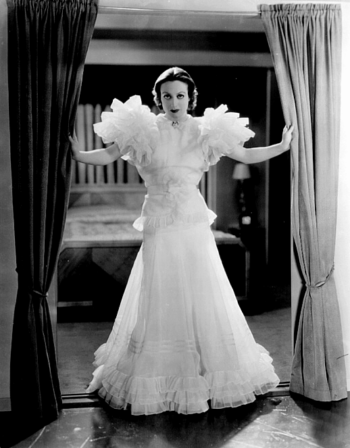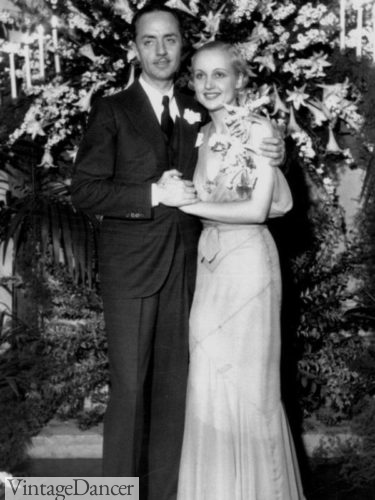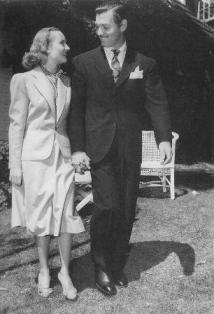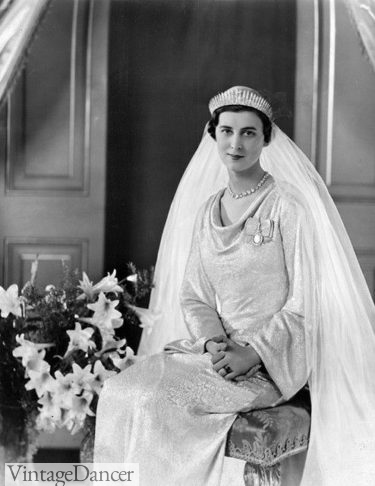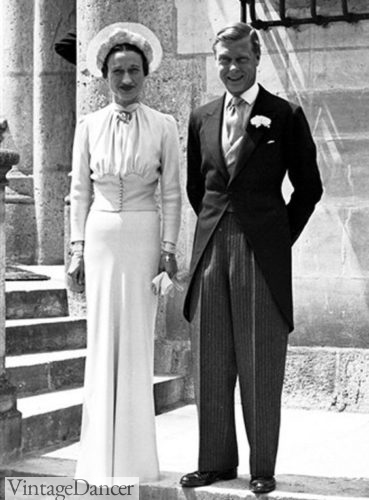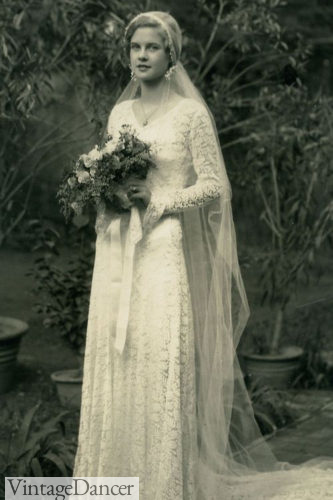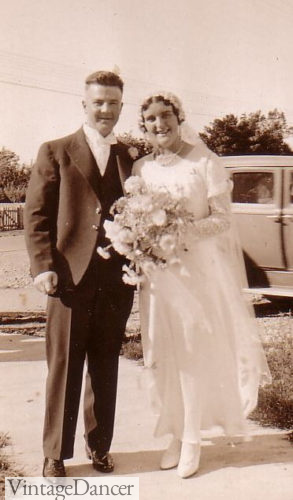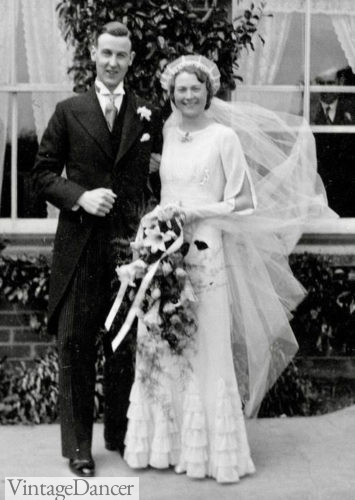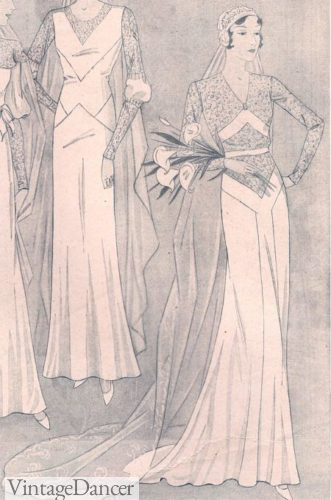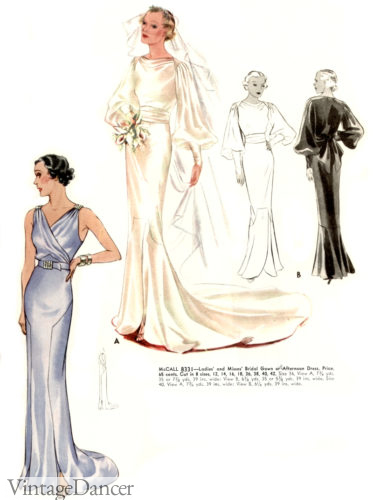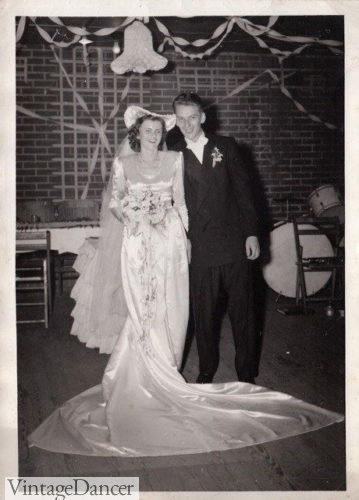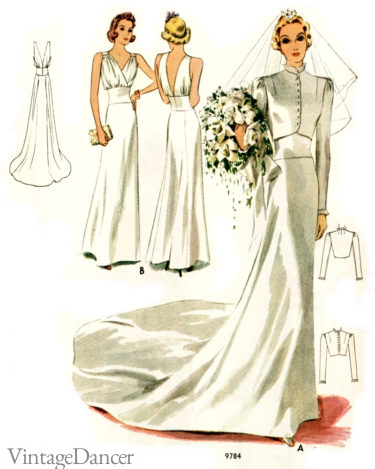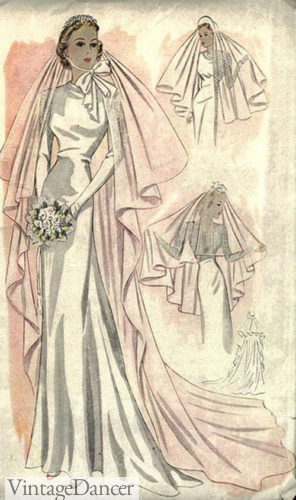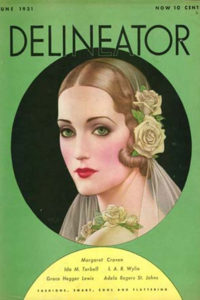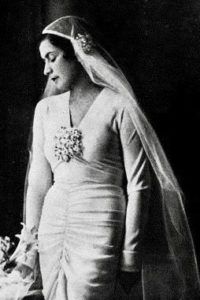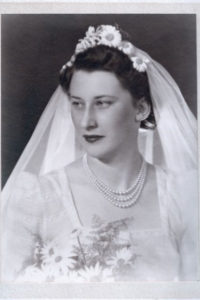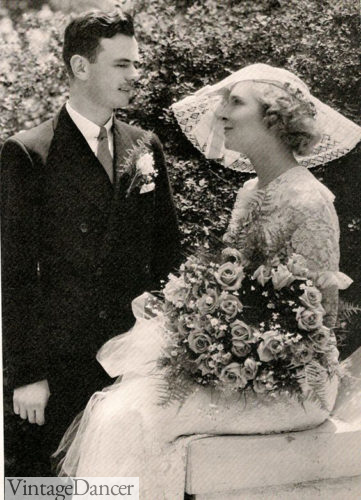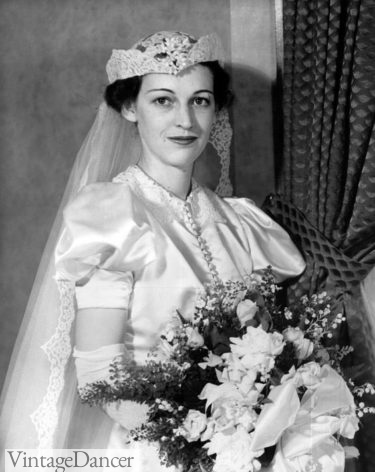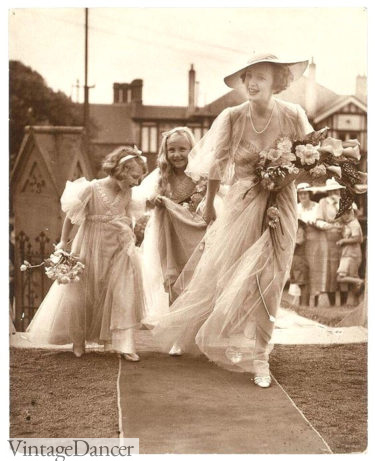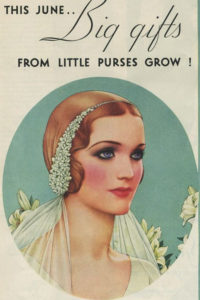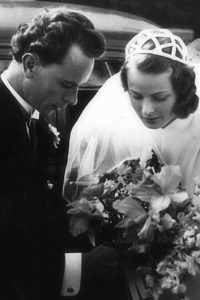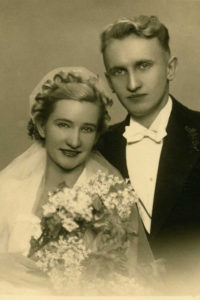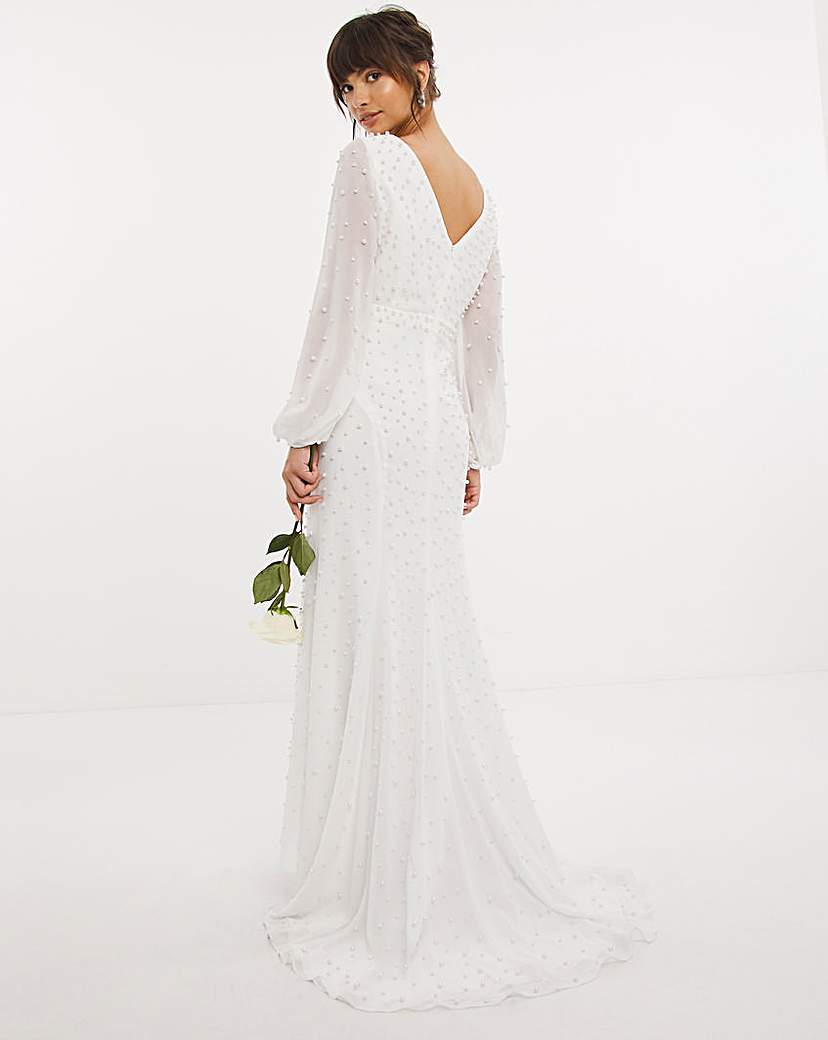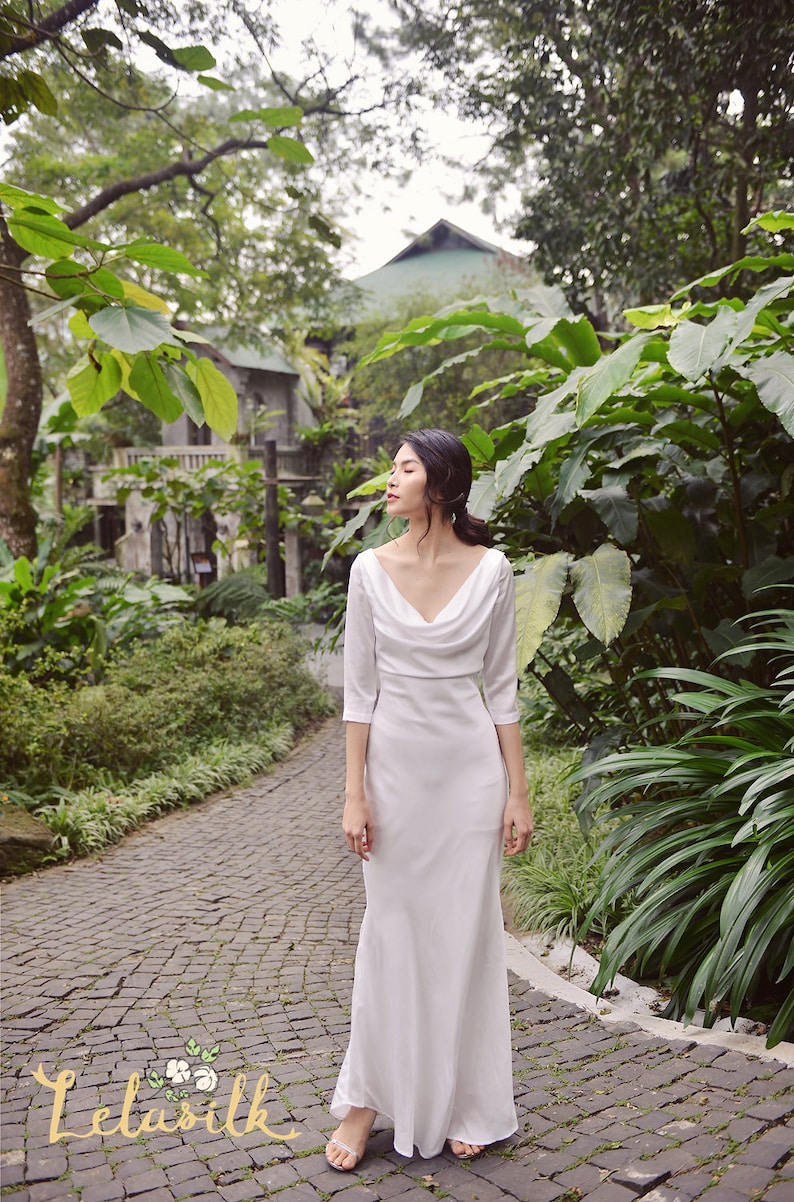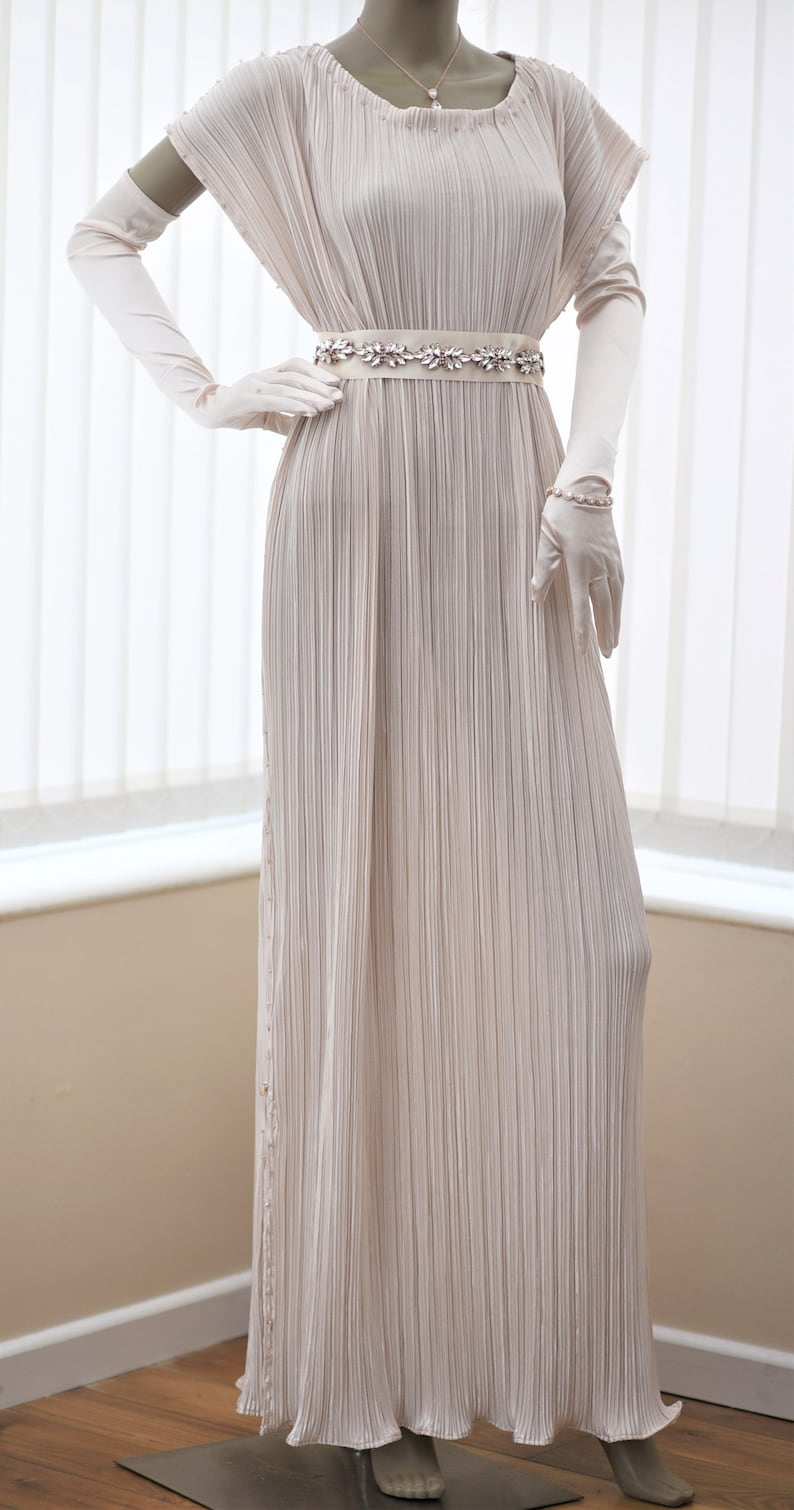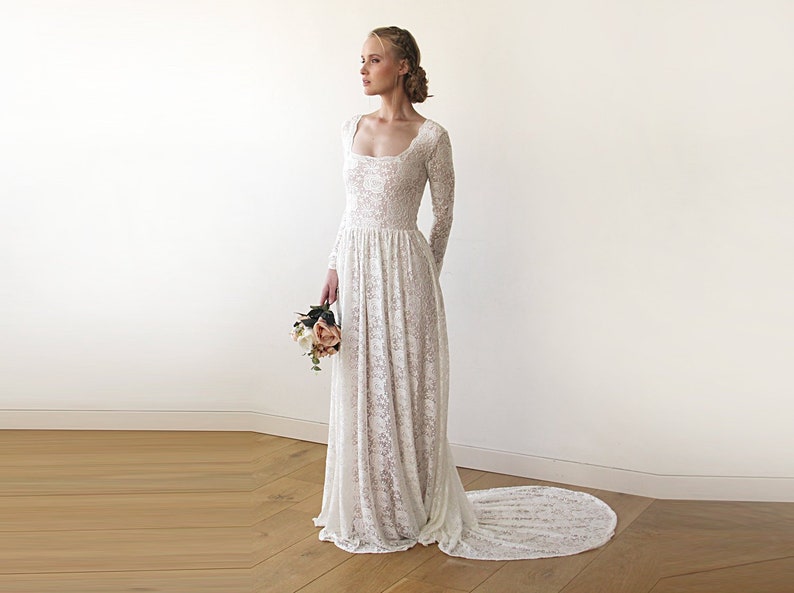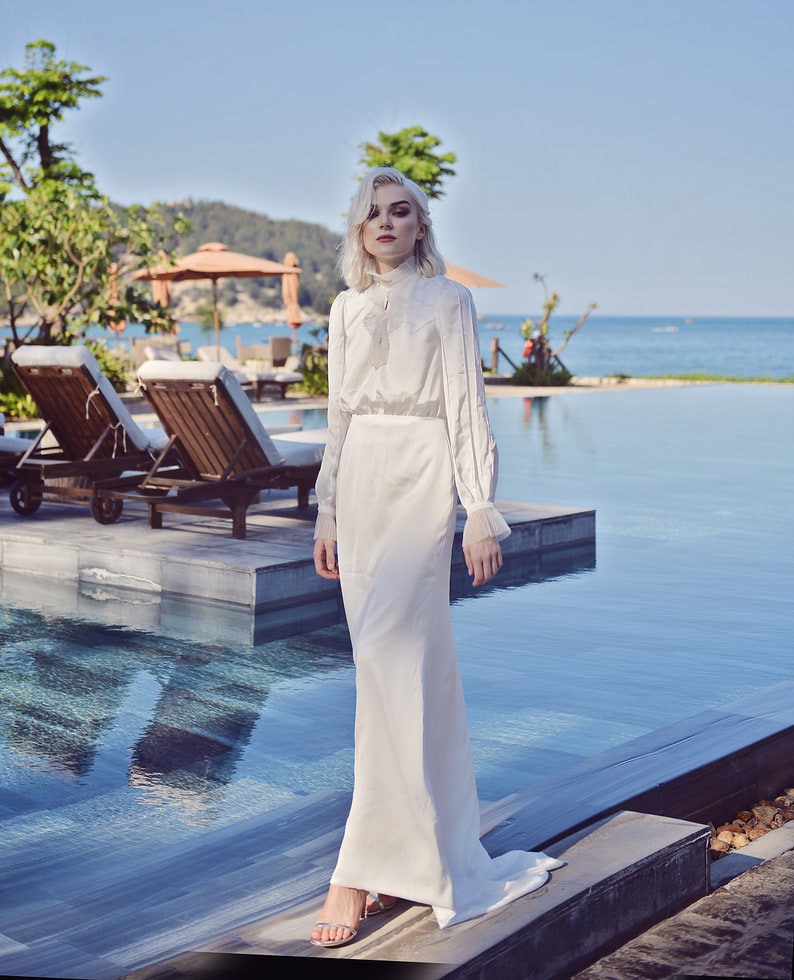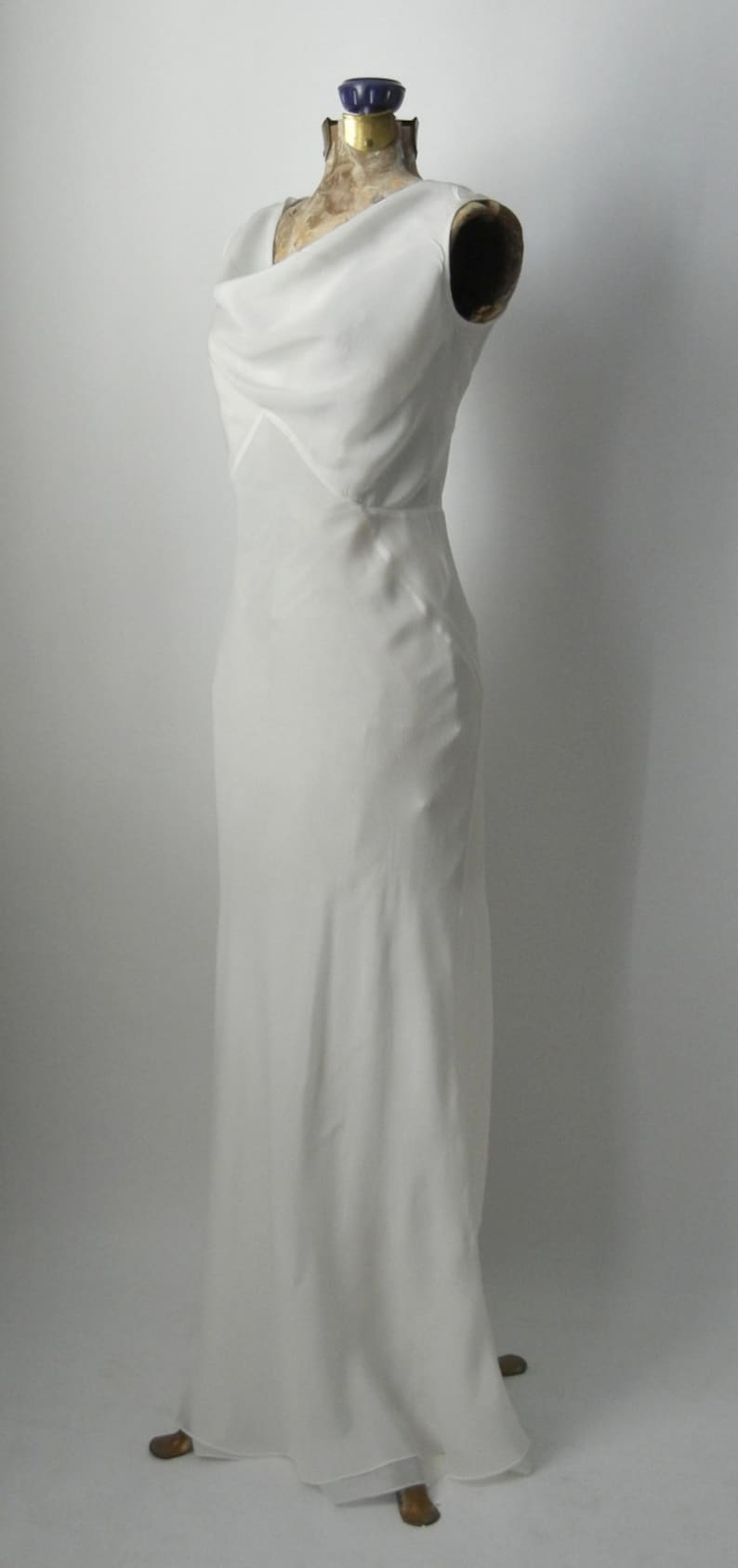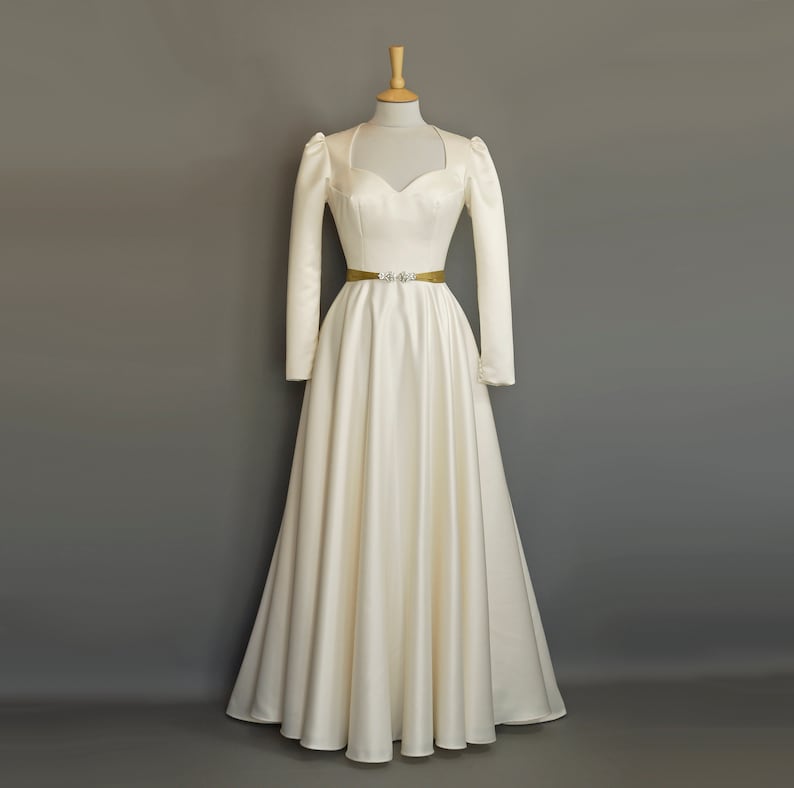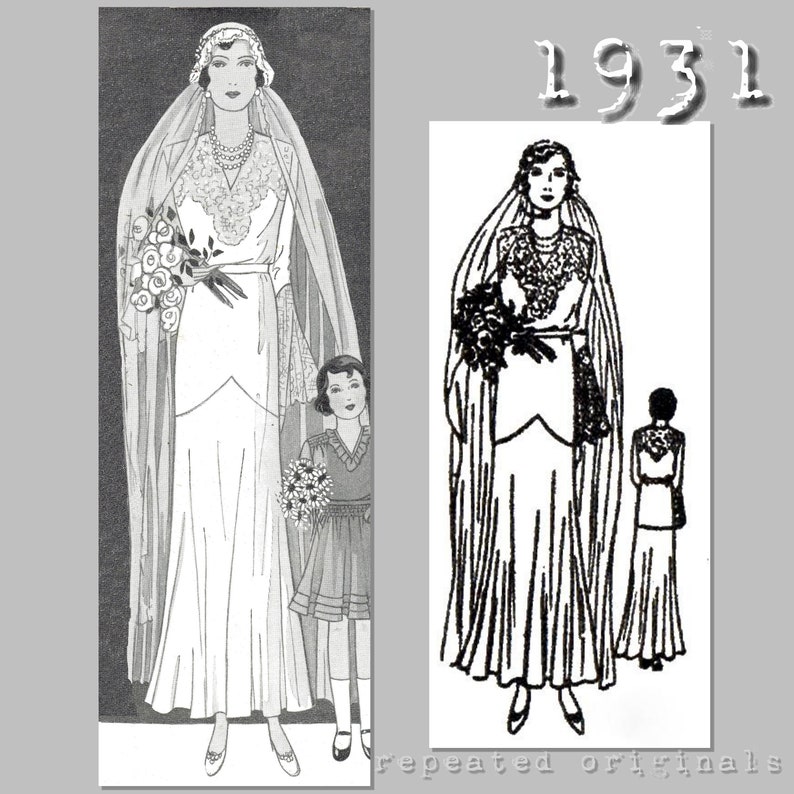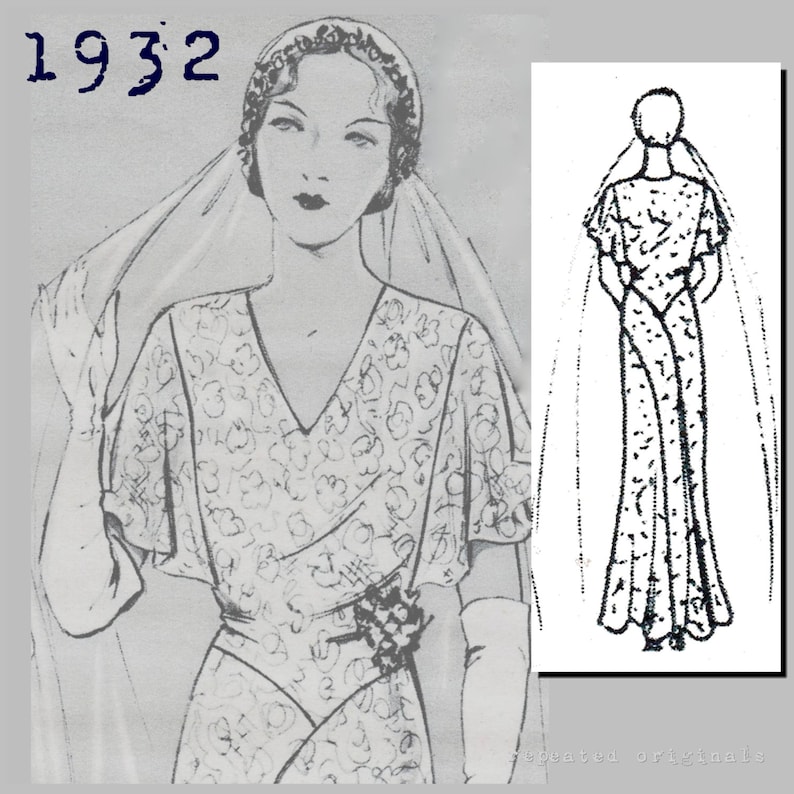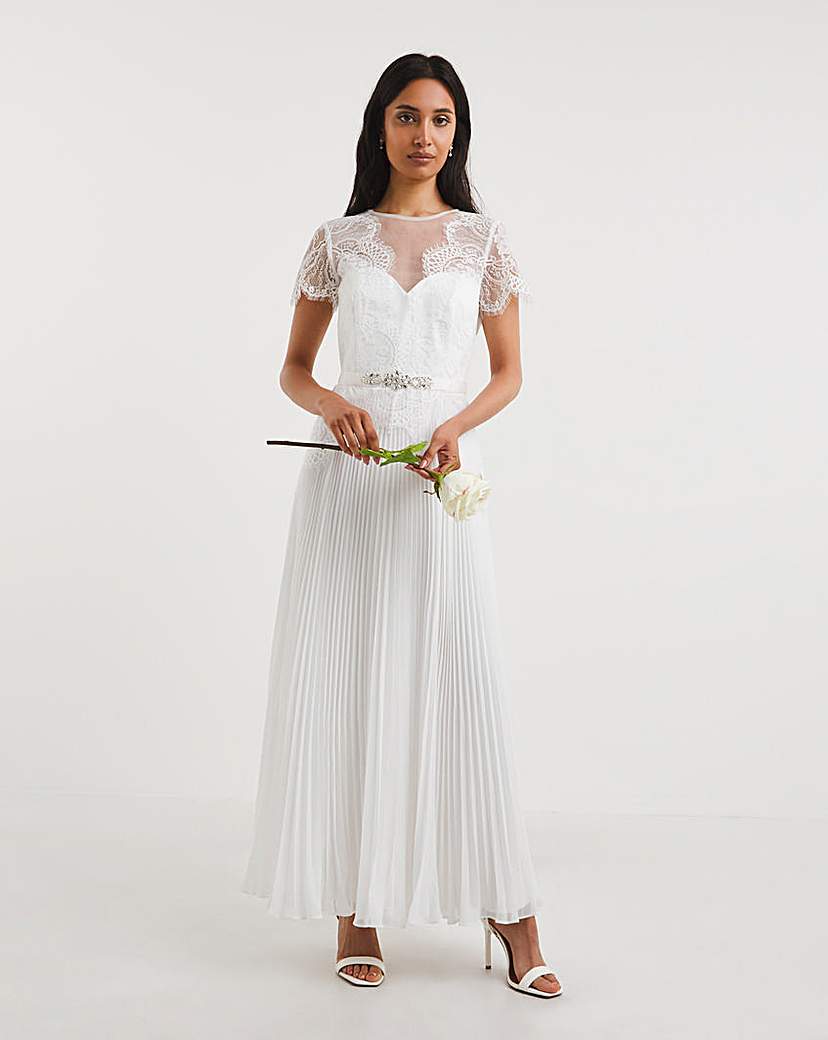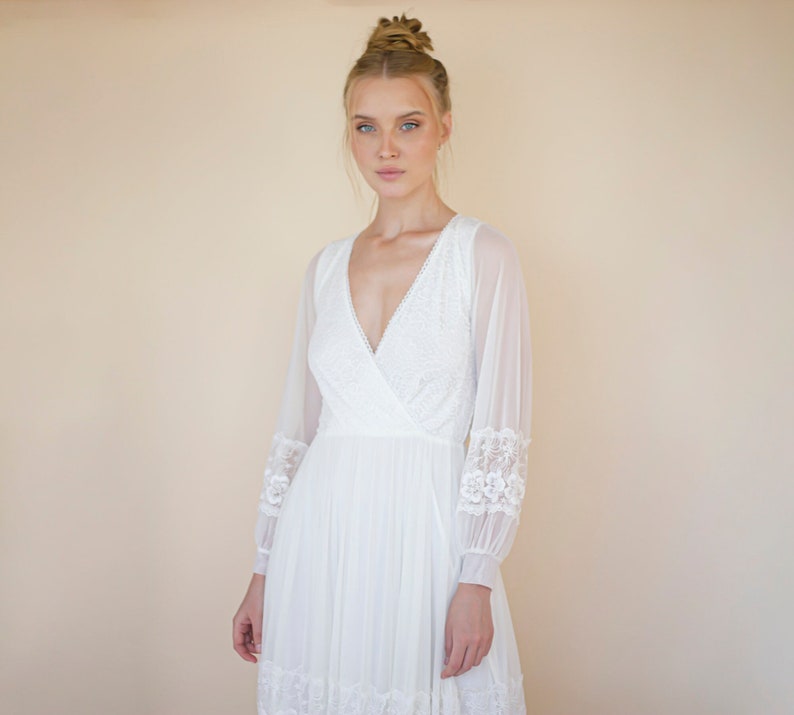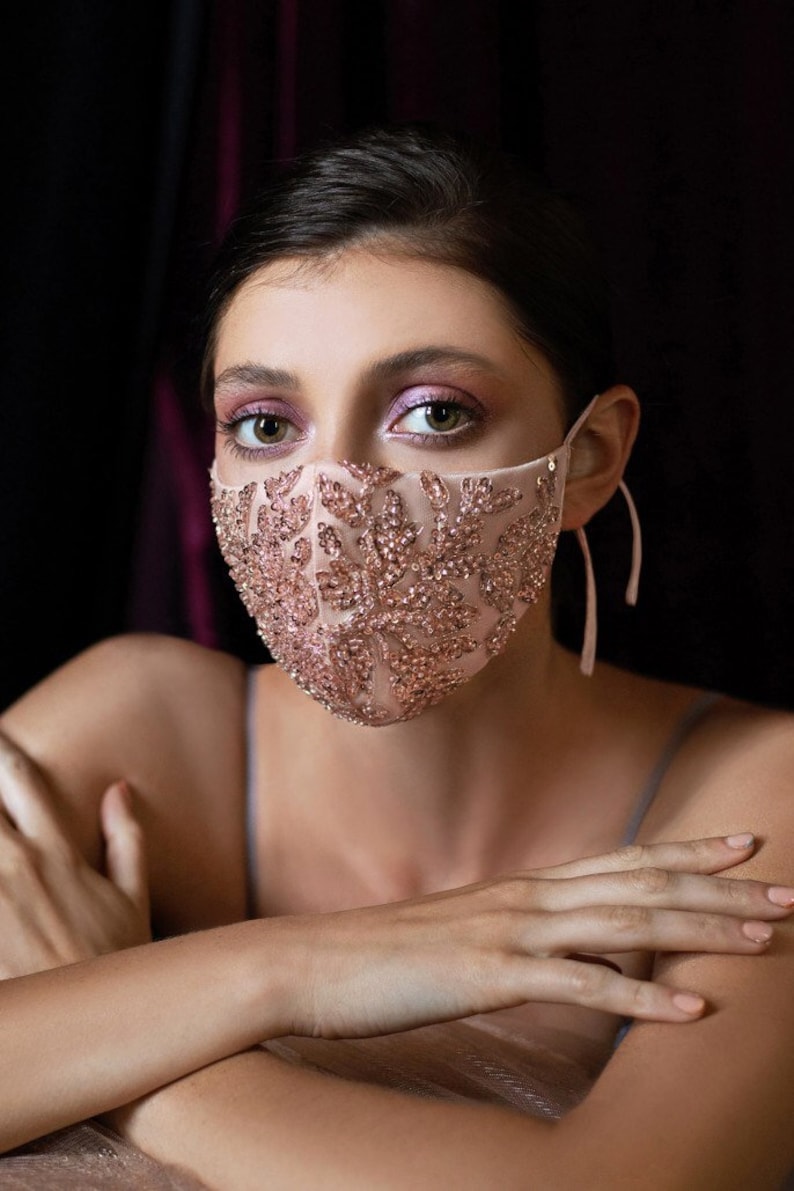“The Bride appears at her loveliest in the new fitted and moulded gowns with long, sweeping lines” Vogue, 1930. Gone were the drop waist short wedding dresses of the 1920s. In were bias cut gowns that slimmed the body in shiny silk, rayon, and satin. Necklines were high, sleeves were long, and accessories were regal. It was the time of high fashion weddings — but on Depression era budgets.
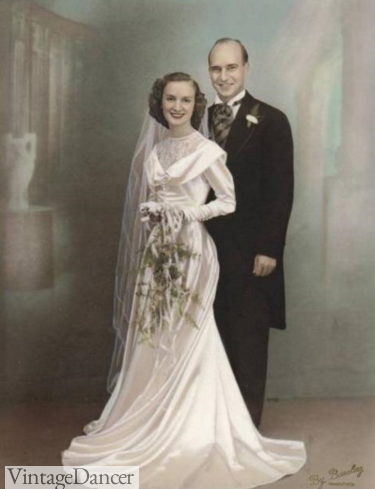
Famous 1930s Wedding Gowns
Most 1930s fashion was taking inspiration from the silver screen. Wedding gowns were no different. Wedding gowns featured in the movies were designer made and affordable only to the rich, but that didn’t stop knock offs from being offered to brides at a fraction of the price. White or light colored party dresses were recreated as wedding gown patterns for brides to be, making the latest designs attainable for all budgets.
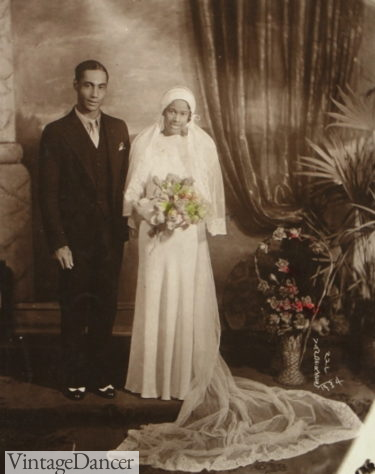
1934 wedding gown with very long veil
The other place to seek inspiration was from the many Royal weddings taking place in the 1930s. Their designs were the opposite of what Hollywood was favoring, but many elements were shared across of the pond.
- Costumer designer Gilbert Adrian designed Joan Crawford’s white organdy party dress in Letty Lynton, 1932, which was widely copied as a wedding gown. The oversized ruffled sleeves are unmistakably ’30s.
- Dedicated bridal magazines appeared in 1936. They helped perpetuate a mass-adoption of specialty wedding gowns, gift, flowers, and home goods. They also reported on Hollywood weddings such as Carole Lombard and Clark Gable in 1939, who wore a light two-piece suit. Lombard’s first wedding in 1931 found her in a sleeveless Deco pieced bias gown with a tie waist.
- Princess Marina of Greece married the Duke of Kent in 1934, wearing an Edward Molyneux white and silver brocade gown with a motif of English roses. The neckline was a modest high V-neck. The court train draped down the from the shoulders. The lace veil was extended with tulle to make in 10 feet wide. The veil was secured with a diamond tiara instead of traditional orange blossoms.
- Wallis Simpson married the former King in a light blue modest bias cut long gown with a row of decorative buttons centered between bust and waist. She wore matching gloves designed to accommodate her wedding ring.
- Joan Crawford in “Letty Lynton,” 1932. The party dress that inspired wedding gowns
- William Powell and Carole Lombard wedding. June 26, 1931
- Carole Lombard Clark Gable, 1939
- Princess Marina of Greece married the Duke of Kent in 1934
- Wedding of Wallis Simpson Prince Edward VIII Duke of Windsor June 3rd 1937
1930s Wedding Dress Trends
- Floor length, bias cut satin dresses
- Long sleeves, high necklines
- Tulle floor length veils
- Tiara style headdress
- Sun hats or small perch hats
- Minimal sparkling white jewelry
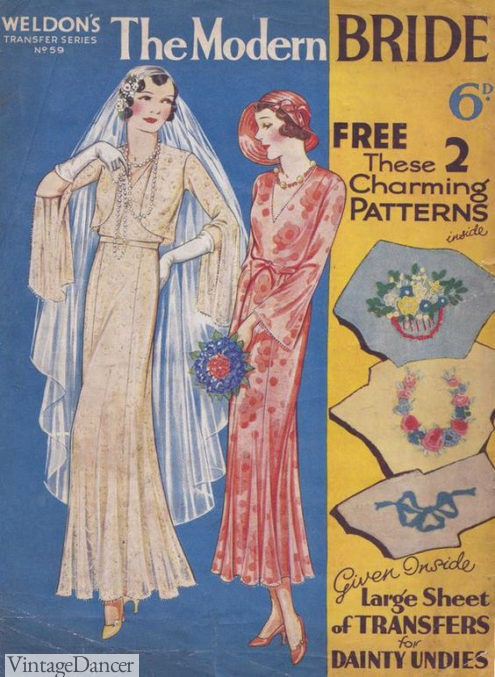
Lace or floral wedding dresses from The Modern Bride magazine
The Depression made it difficult for brides to afford new wedding gowns. Many brides wore their “Sunday Best” dress or a new white dress that could be dyed a color after the wedding. A more popular option in the early ’30s was a silk crepe or chiffon floral tea dress that could be worn any day after the wedding. Matched with a pretty white sun hat, they were pretty and practical — especially in hot climates.
Another DIY option was to upcycle another wedding dress. An older style could be trimmed down, given sleeves, and embellished with covered buttons and trim. A party dress could also be recycled into a wedding dress by modification or by reusing the material. A two piece suit could also be worn to a second wedding.
For those that could afford to handmake a wedding gown, there were sewing patterns and fabric available to purchase from local shops or mail order catalogs. Common fabrics were shiny silk, satin, or rayon that draped beautifully down the body. Lace was also worn in the early ’30s. The fit of wedding gowns was hardly the sculpted look seen on thin movie stars. Instead, most wedding gowns were cut a bit looser, fuller, and even more modest than bridal illustrations depicted.
- 1931 all lace wedding gown with tulle veil
- 1932 bride in handmade modest dress (possibly upcycled from previous family wedding)
- 1930s split sleeve wedding dress with ruffled hem skirt
Skirts skimmed the hips and draped to the mid-calf for daytime weddings, or to the floor for formal weddings. After a decade of short 1920s wedding gowns (ankle or calf), 1930s women were ready to return to the elegance of long gowns. Trains and veils were even longer, running down the aisle both long and wide.
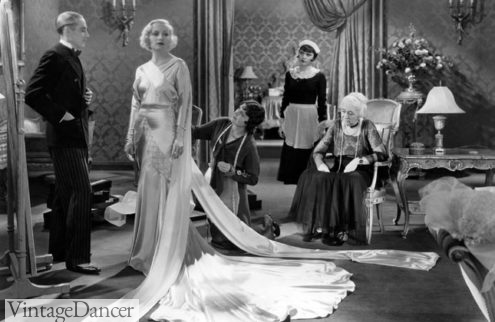
No More Orchids, 1932, Carole Lombard’s cascading wedding gown
Art Deco detailing such as Chevron, geometrics (triangles), and long panels inserted into the gown offered subtle design details in the early 1930s. The middle years saw the waist being accented with belts tied or slide buckled. The end of the decade saw the use of ruching, gathers, and pleats around the waist and neckline to define a more natural hourglass figure.
- 1932, Art Deco piecing with lace and satin inserts
- Simple bias cut wedding down with full sleeves
- 1930s bride in similar gown to the pattern to the left
Wedding dress sleeves were always long- a requirement in most churches as well as a reflection of the fashion of the day. Some brides got away with a sleeveless wedding dress when worn with a short button up crop jacket for the ceremony. Another option were Butterfly sleeves that were a double layer of sheer fabric covering the arms like a small cape or wings. A longer sheer sleeve could be worn underneath or left out for non-church weddings. The split sleeve was another cheat where the sleeve was open around the elbow.
- Optional crop jacket worn over sleeveless wedding dress
- 1933 exaggerated full pleated sleeves
- Plain long sleeves
By 1938 and 1939, the Victorian ballgown returned to fashion, thanks in part to the success of Gone with the Wind as well as visiting Royalty. These crinoline supported wedding gowns and bridesmaid dresses featured huge gigot/leg ‘o mutton sleeves and embellished skirts with garlands, ruffles, roses, bows, and matching bonnet hats. The fad was short-lived, but influenced formal gowns in the 1940s.
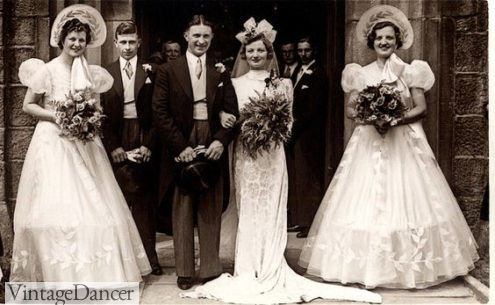
Victorian inspired wedding/bridesmaid dresses
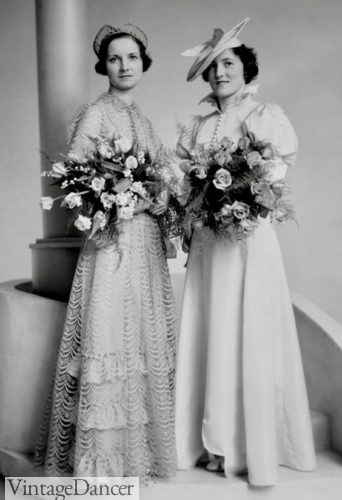
Bridesmaids with the Victorian theme
Wedding Veils
While a lace veil was traditional, tulle was gradually replacing it. Many brides choose a combination of family heirloom lace and tulle for a mix of the old and new. 1930s wedding veils grew longer, reaching the floor like a billowing cape from the back of the head or the shoulder line. Some brides still preferred the skull cap wedding veil, which in the 1920s was heavily embellished. The 1930s version was simply the veil snugly wrapped around the head, with large draping down the back.
- 1931 cap veil with roses
- 1936 cap veil
- 1939 daisy crown with veil
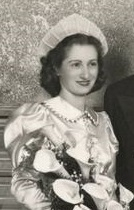
Starched crown
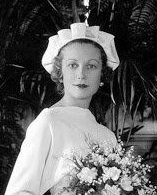
Halo hat circles the head
Veils were usually accompanied by some sort of headdress. Instead of a traditional crown of orange blossoms, the new wedding headwear was the tiara. Some tiaras circled the head like a halo with diamonds or rhinestones that glimmered in the light. Colored gems in Art Deco designs also decorated many tiaras of the upper classes. Middle classes may have used starched lace or small pearls to decorate their fabric tiaras. Every tiara stood up a few inches and circled the head. By the end of the decade, flower crowns returned, sporting daisies, roses, and gardenias.
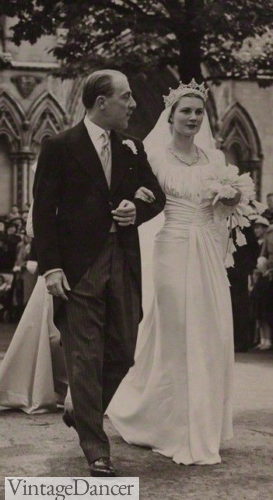
Viscount and Viscountess Cowdray, 19 July 1939 wedding with a jeweled tiara
There was also a trend for hats instead of crowns. Small white hats were perched at an angle over one eye, or large sheer sun hats shaded the bride’s face. The halo hat was shaped like a shower cap. Its round shape extended around the bride’s head, creating the halo effect.
- 1930s sheer lace wedding hat
- Late ’30s wedding hat
- 1935 Wedding hat (Australia)
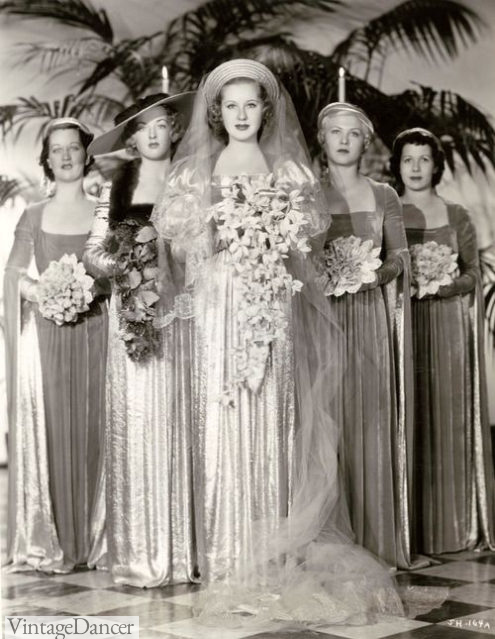
Jane Hamilton wears a round halo wedding hat with veil
Wedding Hairstyles
Bobbed hair was gown out in the 1930s into waves that clung close to the head. Tight curls framing the neck was also popular in the later years. Longer hair was styled into a chignon at the nape of the neck with soft waves framing the face.
- 1932 marcel waves around the face
- Ingrid Bergman with her first husband, Dr. Petter Lindström,1937, wearing softly waved hair
- 1935 crown of curls
Wedding Jewelry
Jewelry was uncommon in wedding attire. With modest dresses covering up exposed skin, there was little need to add ornamentation. Some brides who opted for a more revealing neckline chose to wear pearls or a sparkling necklace. Single or multi stand pearls were the most common jewelry item, especially later in the decade. In the early years, some dresses were accented with rhinestone and diamante dress clips, especially square neckline that called for some sort of decoration. Read more about 1930s jewelry.
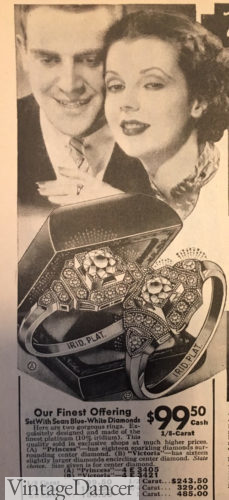
1937 Diamond ring in a Victorian-inspired setting
White paste bracelets were another common option for those who wanted more sparkle. Wallis Simpson wore a diamond charm bracelet with nice crosses inscribed with significant events of the couple’s relationship. Mainstream brides followed her lead, wearing jewelry acquired during the couple’s courtship.
Wedding rings were worn by both bride and groom. While a diamond ring set in platinum Art Deco carvings was the best, natural gold or white gold was more affordable. The designs were also heavily inspired by the Victorian era, with many smaller diamonds circling a center large stone.
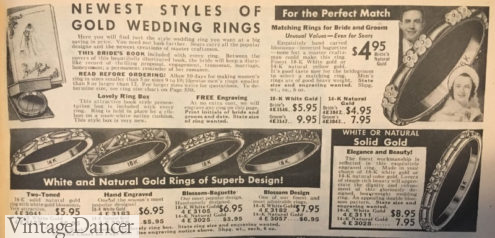
1938 flower engraved wedding bands for brides and grooms
Economical brides and grooms turned to simple, small wedding bands with several small diamonds or carvings of flowers instead. These little wedding rings signified the beginning of a life together where, later, more expensive and large rings were given at anniversary.
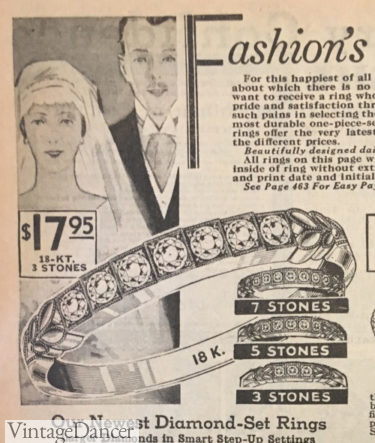
1937 diamond wedding band in gold
1930s Wedding Shoes
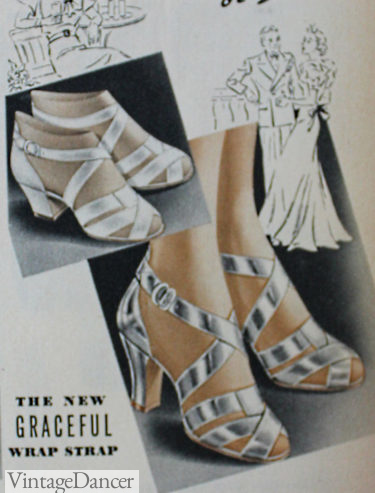
1938 white evening sandals
Since most dresses were long, we can almost never see what shoes brides wore in the 1930s. Our best guess is white evening shoes such as T-straps, Mary Janes (single strap), or multi-strap open toe sandals (pictured left). Solid or perforated slip-on heels would have been another option.
Most wedding shoes would have been made to match the gown or dyed leather. Satin was the most common wedding shoe choice. Some brides went against tradition and wore colored wedding shoes, such as those they might wear with a party dress.
White stockings were always worn with white wedding dresses, even with open toe sandals.
Shop vintage style wedding shoes.
1930s Style Wedding Gowns
A modern 1930s wedding, Art Deco era wedding, or Old Hollywood themed wedding is a perfect setting for a vintage or modern wedding. The bias cut wedding gown has come back in fashion over the last few years, making it easier to find. My favorite brand is in the UK, Ghost London. They consistently make bridal gowns with the 1930s bias cut shaping, satin fabrics, and modest sleeves. See their bridal Instagram for inspiration. The wide range of colors makes them excellent choices for Bridesmaid and mother’s dresses too. In the USA you can sometimes find Ghost London dresses at BHLDN
Besides Ghost, you could look for a vintage wedding dress, veil, tiara, or hat on Etsy or Ebay. For something beaded and sparkly (more ’20s than ’30s), the brands Pisarro Nights and Papell are my favorites. See these and more 1930s inspired Art Deco wedding gowns here.
